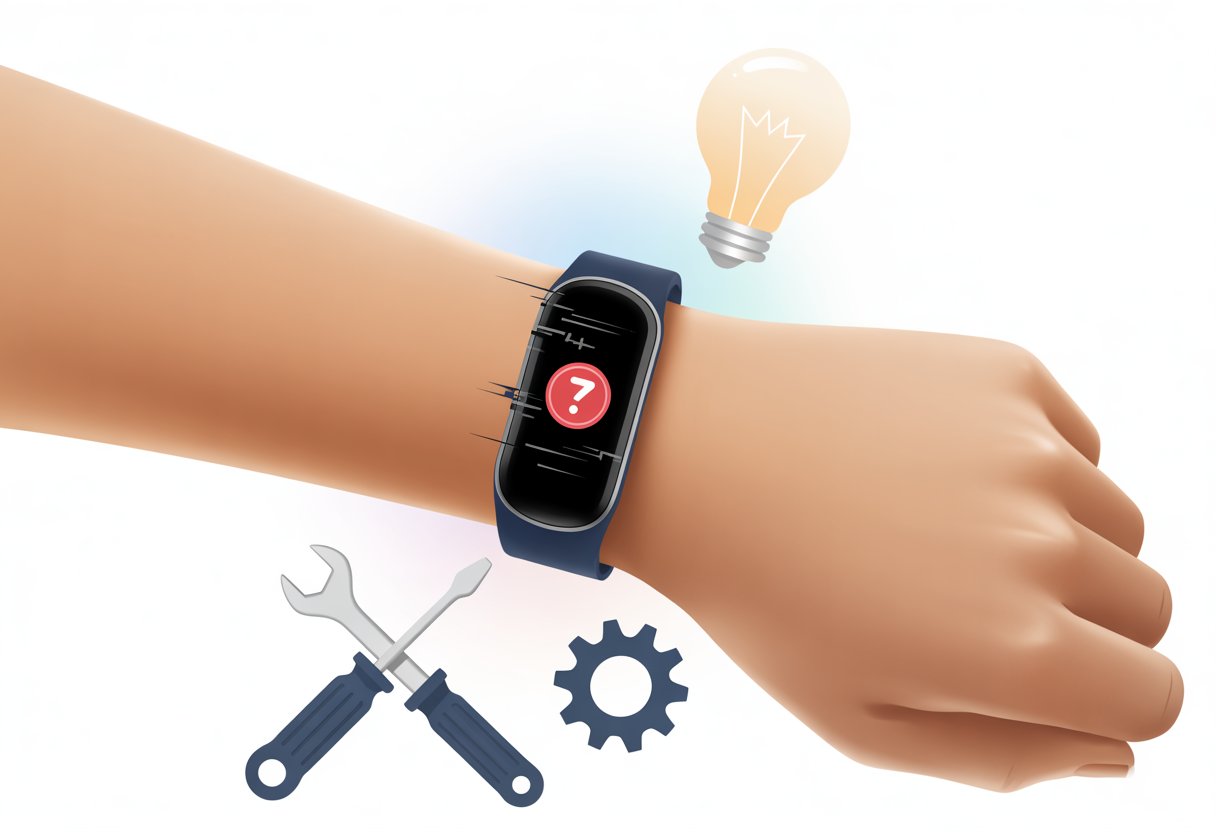Who knew fitness trackers could make us sweat before we even hit the gym? There’s nothing quite like chasing steps, only for our tracker to flash a confusing “501 error” right in the middle of our morning jog.
If our fancy digital coach suddenly puts up an error screen instead of cheering us on, we’re definitely not alone.

Error code 501 on fitness trackers usually means something isn’t working right, but it often has a simple fix we can do ourselves. Sometimes it’s just a random glitch—a quick reset or checking the pairing with our phone might solve it.
We don’t need a rocket science degree to sort it out—just a few steps and maybe a bit of patience.
Before we panic and think our tracker has bailed on our fitness journey, let’s see what error 501 actually means and how we can get things back on track.
Let’s get back to tracking those steps (and bragging rights) as soon as possible.
Understanding Fitness Tracker Error Code 501
When a fitness tracker throws a 501 error, it isn’t just trying to spice up our day with random numbers. This error points to a specific problem that’s usually not our fault.
Fixing it can actually save us from missing out on those precious step counts and heart rate stats.
What Is a 501 Error?
A 501 error is basically our device’s way of saying, “Nope, I can’t do that.” In tech speak, a 501 error is an HTTP status code.
It means “Not Implemented,” which tells us the server we’re asking for help from doesn’t support the action we want—like ordering pizza from a vending machine and getting a salad instead.
Unlike more common issues like a 404 (page not found) or a 500 (server error meltdown), the 501 means our request reached its destination, but the service isn’t programmed to do what we asked.
On websites, the 501 Not Implemented error pops up when the server can’t handle whatever new trick we’re trying to pull off.
In other words, it hasn’t caught up to our latest tech genius idea yet.
How 501 Error Applies to Fitness Trackers
When our fitness tracker hands us a 501 error, it’s probably because it just had a communication breakdown. Usually, our tracker tries to talk to the company’s servers, but the server isn’t set up for whatever data sync or command we just triggered.
It can’t process the request, so it throws up a 501.
This can happen during software updates, account syncing, or when we try out a new feature that isn’t fully supported. Sometimes, the server is just behind on updates or maintenance and can’t respond properly.
Our tracker isn’t broken, but the service it depends on isn’t ready for that specific function right now.
Basically, our fitness tracker’s server said, “Ask me something easier,” and quietly sulked away.
Common Causes of Error Code 501 on Fitness Trackers
When our fitness tracker suddenly flashes an error code 501, it feels like the universe is conspiring against our daily step goal.
There are a few main things that can set off this error, from the tracker’s features to its software and how it connects.
Unsupported Functionality or Features
Sometimes, we get a little too excited and try to use a fancy new function that just isn’t supported by our tracker. Error 501 is the device’s way of saying, “Hey, I have no idea what you just asked me to do.”
This often happens when our apps or trackers haven’t been updated to recognize newer commands, or if we’re trying out features meant for a different model.
For example, using an app that tries to tap into unimplemented features or uses an HTTP method that the tracker’s little server brain doesn’t recognize will quickly trigger this error.
Many 501 errors pop up because the tracker’s firmware or server software just isn’t built to handle certain requests (read more). It’s like asking a cat to fetch—the response is confusion, if not outright disdain.
To avoid these awkward moments, let’s check what features our device supports and steer clear of anything that seems a little too high-tech for our humble wristband.
Outdated Firmware or Software
Fitness trackers can be stubborn. When we skip those firmware or software updates (because who wants to wait for a restart?), we open ourselves up to a bunch of avoidable problems.
Running old firmware may cause the tracker’s mini web server to miss out on crucial instructions on speaking the latest HTTP protocol version. If our tracker doesn’t know what the app is saying, it might just throw up a 501 in protest.
Sometimes, the client-side (the app or web service talking to our tracker) may expect new features from the server side (the tracker) that simply don’t exist yet.
How do we fix this?
- Update the firmware: Let the tracker install the latest goodies.
- Check for app updates: Our phone apps need love too.
- Restart everything: It’s basic, but it works more often than we’d like to admit.
Keeping both sides updated means fewer “not implemented” messages and more actual tracking.
Connectivity Glitches
Let’s be real—Bluetooth and Wi-Fi are great until they suddenly aren’t. A weak or spotty connection often leads to incomplete data transfer between our tracker and the app.
The tracker’s tiny server might miss a request or not receive it properly, causing a 501 error.
Sometimes, even our server configuration can play tricks on us. If it’s set up to expect a specific protocol version or method, and our app sends something unusual, miscommunication is guaranteed.
Imagine trying to order tacos at a burger-only place—the result is confusion and maybe a 501 for seasoning.
A few troubleshooting steps:
| Glitch | Fix |
|---|---|
| Bluetooth drops | Re-pair devices |
| Wi-Fi hiccups | Reset the router/tracker |
| Server confusion | Double-check protocol versions |
A solid connection and matching protocols help our tracker get back to counting steps, not error codes.
Server-Side Solutions for 501 Error
When we run into a 501 error, our server is probably confused or just not cooperating.
To help our fitness tracker get back on its feet, we need to dig into the server’s setup, peek at the logs, and double-check our protocol game.
Checking Server Configuration
Let’s start with our server’s brain: the configuration. If the server isn’t set up to understand the request, it’ll send a 501 error and refuse to work out with us.
First, verify the server configuration settings.
- Double-check that the right modules and features are enabled for the HTTP methods we use (like GET, POST, or DELETE).
- If we’re using older servers, some HTTP methods may be off-limits by default.
Sometimes a missing setting feels like finding our socks in the freezer.
We can also compare our configuration file to a basic template for our server type (Apache, Nginx, etc.) to spot anything odd.
If an update or a plugin broke things, rolling back or tweaking the settings could fix the problem.
Common configuration problems include:
| Problem | Quick Fix |
|---|---|
| Unsupported HTTP methods | Enable missing modules |
| Improper server permissions | Review user permissions |
| Bad config file syntax | Check and correct the syntax |
Reviewing Error Logs
Our server keeps a diary—also known as error logs. These logs love to spill the beans on what’s wrong.
To find the source of the 501 error, check the most recent entries in the server’s error log. Logs usually sit in a folder called logs or under /var/log/ for Linux servers.
We want to look for lines mentioning “501” or “not implemented,” which should give hints about the request and what the server didn’t like.
Let’s add some detective work:
- Look at when the error started.
- See if it happens with every request, just certain users, or certain features.
- Trace it back to any changes made right before the errors.
By catching the exact offending line in the log, we get a clue about the misbehaving request or configuration.
Sometimes, just reading the error log saves us hours of unproductive head-scratching (log tips here).
Updating HTTP Protocol Version
Let’s talk about our communication style with the server. The HTTP protocol version decides what requests the server can understand.
If our fitness tracker or client device uses a new HTTP method (like PATCH or OPTIONS) and the server only supports HTTP/1.0, a 501 error is almost guaranteed. Check the documentation to see if both sides—server and fitness tracker—talk the same language.
We may need to:
- Update the server software to support HTTP/1.1 or HTTP/2.
- Enable protocol features that recognize more modern HTTP requests.
A protocol mismatch is a classic “lost in translation” problem.
Upgrading the server or application stack can open up a world of supported features and reduce the chance of “not implemented” complaints (learn more here).
Client-Side Fixes for Fitness Tracker 501 Errors
When our fitness tracker gives us a 501 error, it’s often our own device or app acting up, not the company’s servers.
Common fixes include restarting, updating, or reinstalling things on our end—basically, routine tech magic spells for stubborn electronics.
Restarting and Resetting Your Fitness Tracker
Before we assume our tracker is broken forever and start researching new hobbies, let’s try the classic trick: restarting it.
Turn the device off, then back on. Sometimes, this simple move will fix weird glitches and shake loose a stuck 501 error.
If our tracker keeps playing hardball, a factory reset can often do the job, but keep in mind: this nukes our settings, preferences, and stored data. Backup any important stats before starting.
Steps may vary by model—some devices use a combination of holding buttons, while others have options right in their menus.
Check the manufacturer’s website or support guide for the right reset steps.
Don’t forget to disconnect and reconnect our tracker from the phone if issues persist. This triggers a fresh handshake between the two, and honestly, sometimes that’s all it takes.
Updating Device Firmware
Outdated firmware is like using a GPS from 1995—sometimes it’ll get us there, and sometimes it’s just confusing.
Device manufacturers regularly release firmware updates that squash bugs and patch holes, making error codes like 501 less likely.
We should check for updates like this:
- Open the tracker’s companion app.
- Find the section labeled Device Settings, Firmware, or something similar.
- Tap Check for Update (or, if we’re feeling lucky, enable automatic updates).
Make sure our tracker is fully charged before starting updates. A dying battery during installation can create even bigger problems.
Once the update is done, restart our device to make sure all the changes stick.
If download or installation fails, try connecting to a more stable Wi-Fi network—public coffee shop internet is a classic culprit for failed updates.
Reinstalling or Updating Companion Apps
Our trusty companion apps can sometimes get tangled up with cached data or bugs.
When a 501 error pops up, the app itself might be at fault, not the tracker. The fix is refreshingly simple: uninstall the app, then reinstall it from the official app store.
Make sure to log back in with the same account—that way, our glorious activity streaks live on.
If uninstalling feels too extreme, try updating the app first. New versions clear out pesky bugs and enable better features.
Clear the app’s cache if problems continue; this step is especially helpful on Android.
Go to our device settings, select the app, then tap Clear Cache.
Sometimes, it’s really just a bit of leftover digital junk slowing things down.
For more causes and solutions around 501 issues, check out this detailed guide for extra troubleshooting tips.
Network and Connectivity Checks
Even the best fitness trackers just… stop connecting to Wi-Fi or Bluetooth sometimes. Before we freak out, let’s look at a few settings that usually trigger error code 501.
Simple fixes—like resetting the network or tweaking a browser setting—might save us hours of headaches (and, honestly, a few choice words).
Testing Wi-Fi and Bluetooth Connections
Let’s start with Wi-Fi and Bluetooth. Make sure the tracker connects to the correct Wi-Fi network—not the neighbor’s “FBI Surveillance Van,” tempting as that is.
Trackers can silently drop connections, so a quick disconnect and reconnect might actually work.
If that doesn’t help, reboot the fitness tracker and the router. Sometimes toggling airplane mode on the tracker for a few seconds, then turning it off, does the trick.
For Bluetooth, double-check that the device is in range and not, say, buried under laundry.
If things still act up, try removing the network from the tracker and then rejoin it. This trick, which folks use for Garmin smartwatch Wi-Fi issues, often fixes weird connection errors.
Examining Proxy Settings
Proxy settings can really trip us up. If your internet runs through a school, office, or any “helpful” network filter, a proxy might be lurking.
Check these things:
- On your phone or computer, head to network settings and look for any active proxy connections.
- Make sure you haven’t accidentally enabled a VPN or proxy app—trackers can get cranky about those.
- Remove any extra proxy settings and try connecting again.
Still no luck? Ask the network admin (or your techy cousin) if there are firewalls or filters blocking your device.
These hidden blocks break app connections all the time, especially with fitness gadgets.
Addressing Browser Cache Issues
Sometimes, the real problem is the browser cache—a digital junk drawer of old files and random clutter. If your tracker uses a companion site or app, leftover cache can block new logins or updates.
Clear the cache every so often to keep things smooth.
Here’s how:
- Open your browser and go to Settings > Privacy > Clear browsing data.
- Select Cached images and files—don’t worry, your embarrassing search history stays if you leave that box unchecked.
- Restart the browser and give syncing another shot.
If things still don’t work, try a different browser or device. At least you’ll have a nice, clean browser—one less reason to put off your next workout.
Advanced Troubleshooting Tips
If error code 501 keeps popping up, it’s time to dig deeper. Grab your detective hat (and maybe some safety goggles, just for fun) as we look for help and compare notes with the pros.
Working with Technical Support
When nothing else works and your stubborn gadget still flashes 501, it’s time to call tech support. Always check the official user manual or a solid troubleshooting guide first.
If that doesn’t help, gather your info—error messages, screenshots, device model, and a list of what you’ve already tried.
This saves time and makes you sound like you know your stuff. During the call, patience helps (maybe keep a stress ball handy) as you walk through their reset rituals.
Support teams often have access to fixes you won’t find in the manual, and they might walk you through secret button combos or even flash new firmware.
Comparing With Similar HTTP Status Codes
Let’s be honest—“501” sounds almost dramatic, doesn’t it? But what does it actually mean?
In the world of HTTP status codes, 501 stands for “Not Implemented.” So, our device basically shrugs and says, “Nope, not doing that.”
Sometimes, our fitness tracker just refuses to run a feature or make a connection it doesn’t support. Other codes, like 400, mean “Bad Request.” There’s also 404—everyone’s seen that one. That’s “Not Found.”
But 501? That one’s different. It pops up when the function or request simply isn’t there, which is kind of annoying. Why does our device suddenly get so stubborn?
Honestly, keeping an eye on these codes can help us figure out if we’re dealing with a firmware issue, or if it’s just another classic “computer says no” moment.
- Why is my fitness tracker not showing Facebook notifications? Your Steps Count, But Your Likes Don’t - November 8, 2025
- Fitness tracker error code 501 fix: When Your Tracker Needs a Fitness Break Too - November 8, 2025
- Fitness tracker Bluetooth error code 43 fix: Why Your Step Counter Thinks It’s in Witness Protection - November 7, 2025






